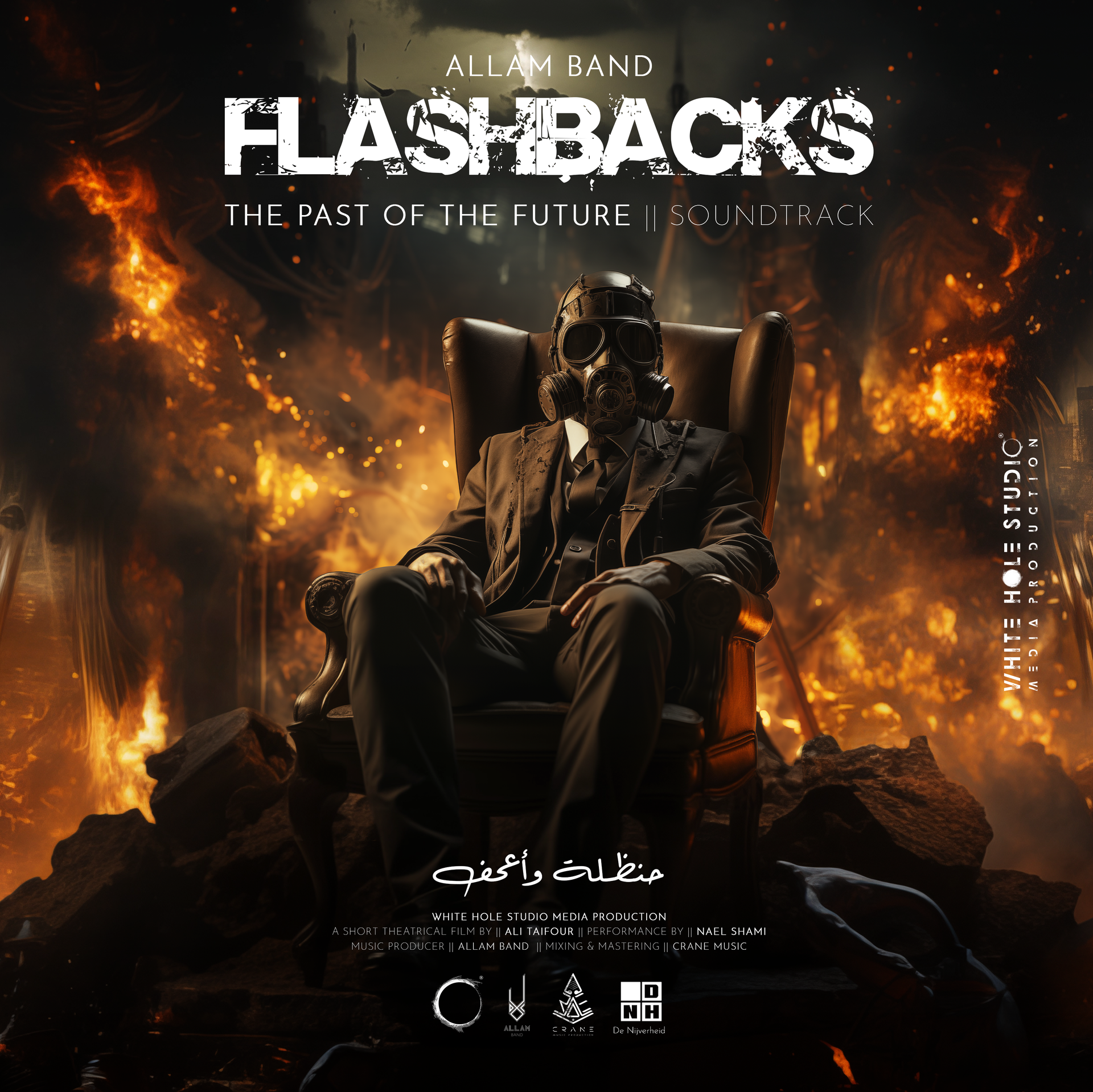Flashbacks
A short theatrical film, made by Ali Taifour
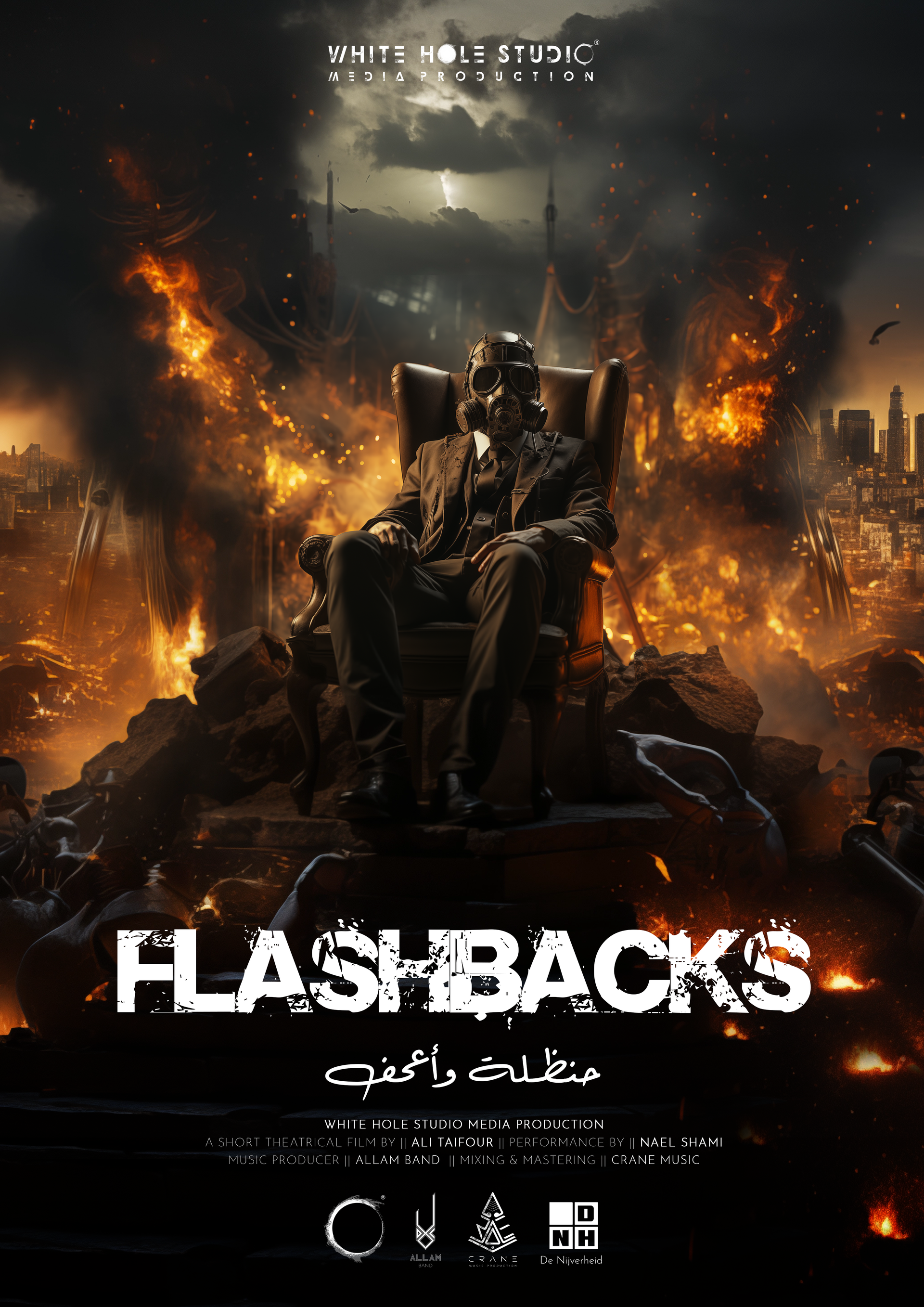
TITLE
II Flashbacks II
حنظلة و أعجف
TYPE OF PRESENTATION
II SHORT THEATRICAL FILM
MADE BY
II Ali taifour
Performance
|| Nael Shami
Music producer
|| Allam band
PRODUCTION II WHITE HOLE STUDIO
WHITE HOLE STUDIO II MEDIA PRODUCTION
DURATION
II
4 MIN 30 sec
DATE & LOCATION
II Utrecht, 16-05-2018
DATE & LOCATION repro. II UTRECHT, 30-11-2023
Flashbacks
A SHORT THEATRICAL FILM
Flashbacks is a short theatrical film, made by Ali Taifour, that tells about the memories engraved in the head. The same stories are repeated, but with different characters, names and places, continuing until now. It tells about the experiences of war in various parts of the world. It is also classified as an experimental short film. As for the secondary title of the film: Handala & A'ajaf.
Handala
Handala is a symbolic embodiment of the Palestinian people, was brought to life by the political cartoonist Naji al-Ali in 1969. Evolving into its final form by 1973, Handala swiftly became the hallmark of al-Ali's illustrations, standing as an iconic emblem of Palestinian identity and resilience. The character draws its name from a local plant, embodying a deep connection to Palestinian heritage.
Fixed at the age of ten, Handala mirrors the age at which al-Ali departed Palestine, vowing not to age until returning to a liberated homeland. Handala's distinct posture, with its back turned and hands clasped behind, signifies a steadfast refusal of external remedies and adverse influences. Evident on walls, buildings, and even in souvenir shops across the West Bank and Gaza, Handala extends its reach through graffiti art, tattoos, and jewelry, deeply embedded in Palestinian culture.
Despite al-Ali's tragic assassination in 1987, Handala persists as a powerful symbol, encapsulating a righteous cause and finding resonance within movements like Boycott, Divestment, and Sanctions.
Naji Al-Ali's unwavering belief in Handala's enduring legacy ensured that the character transcends his death, becoming an everlasting representation of his steadfast ideals.
trailer
A'AJAF
A'ajaf was born during the Syrian war, in the year 2011 by Ali Taifour. The emergence of A'ajaf coincided with the onset of the Syrian conflict, a poignant symbolic figure embodying hope amid turmoil. Ali Taifour immortalised A'ajaf through a drawing first published in 2015, depicting A'ajaf hand in hand with Handala, gazing upon the combined maps of Syria and Palestine, yearning fervently for the restoration of peace to their lands.
Unlike Handala, A'ajaf ages over time. His countenance remains obscured until Syria flourishes and advances urbanly, artistically, culturally and, above all, a renaissance that comforts the souls of its people, dead or alive.
Ali Taifour asserts the significance of their symbolic death, marking the return of rights to their rightful owners and the widespread establishment of peace and security. He staunchly opposes the creation of new symbolic characters, wishing instead for life to progress unencumbered. A'ajaf's aging serves as a testament, documenting the duration required for rebuilding from the war's inception until the rekindling of life and prosperity.
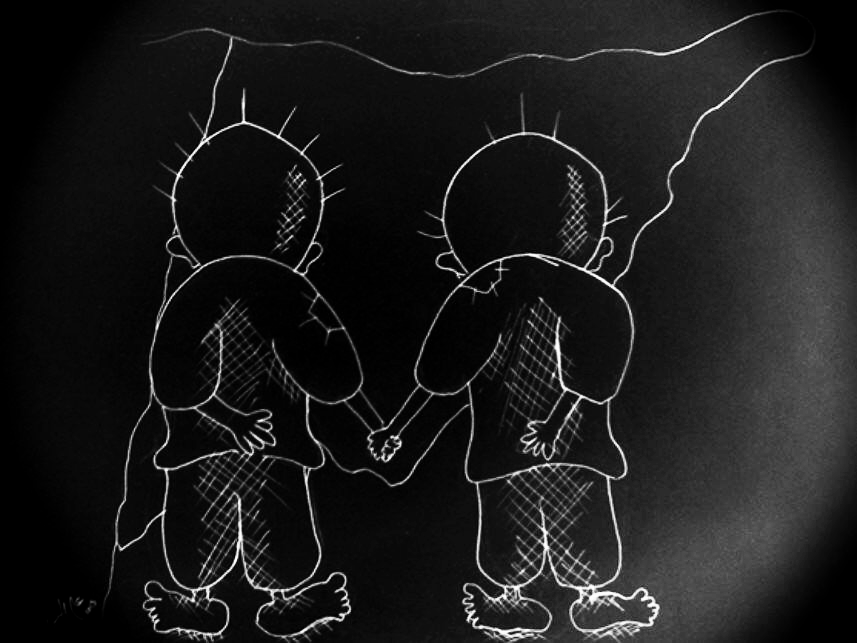
Echoes of Conflict: A Cinematic Symphony
The idea of this short theatrical film follows two parallel lines: the first: the viewer, the second: the sound. It intersects in some areas and diverges in other areas.
The First Parallel Line "The Viewer" II The Scenes
Amidst numerous scenes, of which the viewer sees, the spotlight rests on an individual seated in a chair, steadfastly clinging to power, unmoved by the present or impending catastrophes. As we piece together previous elements, a fleeting yet vivid montage flashes through our minds, laden with intricate details, encapsulating the essence of the situation in mere seconds.
The Second Parallel Line is Sound
As for the sound, there are also two lines:
- music:
The piano piece was played by Ali Taifour in the year 2015 when he was living in Syria - Aleppo, from the womb of the Syrian war, trying to express the state of fear and loss and the search for hope in the darkness of the dark tunnel of war, and this piece is part of the music for a short film, which is being produced by White Hole Studio, and will be released within the next two years, under the title (My Universes), where the music tells the experience of living in the midst of war, and searching for ways to survive, whether taking refuge from the scourge of war, or even building a bubble that protects the mind from sickening.
The music composition by Ahmed Islam Al-Tanabi was born amidst the war in Gaza in 2023. By weaving in musical phrases that narrate and solidify the theme, it forms a cohesive piece. Its purpose is to serve as a reminder, emphasizing the necessity of halting conflicts, portraying the psychological toll, and advocating for global pursuit of transformative solutions to cease wars worldwide. It strives for a future where peace and security prevail, urging collective efforts for a harmonious and secure world. - sound effects: The documented Sounds of the TERROR and WAR during the Syrian war.
watch flashbacks
The scenes of Flashbacks
Intro
The film commences with a momentous sound, echoing the emergence of darkness unfurling an iron gate—a visual representation of 'Opening the Door of Memories.' Concurrently, a resonating Arabic proverb reverberates: 'You opened for me the door of the pains.' Simultaneously, a gentle rustle akin to a light breeze is heard, symbolising 'The Calm Before the Storm.' As the scene unfolds, the soundscape seamlessly melds with the rising crescendo of the musical score, steadily intensifying until it reaches a point of stability.
The second scene
The scene unfolds with a person seated on a chair, his back to the camera, bathed in a spotlight—a symbolic onset of interrogation and investigation. Wooden panels in front representing both prison cages and buildings. Flies' sporadic buzzing, alternating sides, signify three layers of meaning: firstly, the person's disdainful perception of others as beneath him, and cares not one bit about them; secondly, the association with flies gathering on victims' remains; and thirdly, the director's viewpoint, expressing the dire situation as an analogy to illustrate pervasive selfishness leading to a trash state. Throughout, the camera captures these details, transitioning from a wide shot to a close-up of the person's feet, symbolising stability and strength in this evocative setup.
The Third scene
The escalating voice of a 13-year-old child resonates through the walkie-talkie, urgently calling for action to escape. However, this plea is abruptly interrupted by a distorted sound, hinting at the presence of misleading information. Responses echo in reaction to the call's status. Meanwhile, the camera dynamically shifts to align with a line parallel to the shape of the stairs, symbolising the ominous commencement of decadence.
The fourth scene
The camera, initially at ground level, orbits around the chair and feet, solidifying the perspective of the second scene. Elements intermittently alternate between light and shadow, symbolically emphasising the insignificance of certain aspects while obscuring the crucial pillars. Concurrently, voices of a multitude echo, mentioning various area names. The cacophony intensifies, steadily escalating into a crescendo of confusion.
The Fifth scene
As the interrogation ensues, the person gestures fervently, attempting to rationalise and seek excuses for their actions. Suddenly, their demeanor shifts, and they commence singing, adopting a solemn, resonant voice as if invoking a hymn. The chant echoes: "Underground, there is a child standing to leave this town." In the distance, a voice calls out "Free Palestine!"
The sixth scene
The scene unfolds with the piercing sound of an alarm bell, setting a tense atmosphere. The camera ascends from the feet, climbing steadily towards the head, a visual representation of the uphill battle and the ascent to confront the pinnacle of corrupt power within the pyramid. Meanwhile, the individual readies themselves, donning a gas mask as a shield, a solemn preparation for an impending conflict, and war.
Following that, the scene transitions to a blanket of white snow obscuring the wreckage of residential homes, a poignant symbol of the countless innocent lives lost amid the ravages of war. Rain begins to fall, signifying the onset of a storm, while haunting echoes of a girl's cries resonate alongside the ominous beat of war drums.
Amidst the chaos, the corrupt figures remain entrenched in their seats, unmoved and unyielding. Their steadfast posture embodies not only their refusal to relinquish power but also their blatant disregard for the victims, a chilling portrayal of numbed emotions and the death of their conscience.
In the backdrop, the individual alternates between donning the gas mask and appearing without it, symbolizing a facade of shifting personas and deceptive tactics presented to the nations and societies. This manipulative act aims to improve their external image while internally, the grim reality unfolds—a process of mass slaughter and genocide. Gestural movements of justification accompany these actions, attempting to rationalize and excuse the heinous deeds.
The scene is punctuated by the distant sound of an airplane, embodying the multifaceted symbolism within: an emblem of the escape process, the search for legal loopholes, and the harrowing reality of warplanes bombing defenseless civilians. As the massacres conclude, the symbolic mask, worn throughout, is finally removed, perhaps exposing the reality left in the wake of devastation and unveiling the truth behind the facade.
The seventh scene
The corrupt figure breach the fourth wall (the gaze piercing through the imagined barrier between actors and audience, directly addressing the viewer). With a chilling certainty, he means, "You, you are next, for I hold the power of justification and absolute control over all." His assertion continues until a new arrival steps into the scene, mirroring the same destructive qualities. However, overwhelmed by the inability to fulfill their ambitions, the culprit bows their head in defeat.
Amidst swirling dust, a figure emerges—a powerful symbol of rebirth from the depths and rubble, signifying the fervent rise of freedom. The music crescendos, echoing the intensity of confrontation.
- The singer's voice breaks the tension, stating, "We are Crying, and Dying"
- In response, voices unite, proclaiming, "We are born from the dark."
- The singer echoes twice: "For Nothing!"
This poignant repetition signifies the countless lives lost in pursuit of exclusive interests and ambitions, urging peoples to unite in rebuilding rather than destroying the world.
As the scene unfolds, the discovery of the gas mask on the chair marks a decisive moment. It becomes a symbol of choice—either embracing an end wrought with destruction or vacating the seats of power, paving the way for peace and the flourishing of life on Earth.
The eighth & last scene
The ticking of a clock resonates—a poignant symbol of time's significance, the urgency to seek something precious before it slips away, and the swift pace of flashback memories. Simultaneously, the gate, once open at the film's outset, now slowly closes, marking the end of a journey and the passage of time.
notes worth mentioning
- The sequence from 01:11 to 01:43 reveals intermittent appearances of the exit gate icon in the backdrop. Meanwhile, the director poses a pointed question: "Why did you choose to remain seated and justify your actions rather than escaping before disaster struck? And in the end, after escaping, what did you truly achieve?"
This inquiry, layered with the symbolism of time, reflects the filmmaker's aspirations and hopes for the onset of a renaissance and reconstruction in the Levant "Bilad El- Cham", anticipated in the year 2043.
- At the 03:33 mark, a person emerges in the upper left corner following the initial figure. This symbolic presence signifies those corrupting from the shadows, shrouded in anonymity, suggesting that their consciences will eventually confront them, serving as an indication of the impending judgment they will face.
- Notably, this impactful work was created with a budget of 0 euros, utilising a Samsung S8+ device for filming, a single overhead light, two lights resembling the green escape door, wooden pallets, and a pallet jack for camera movement.
flashbacks's Poster

film soundtracks
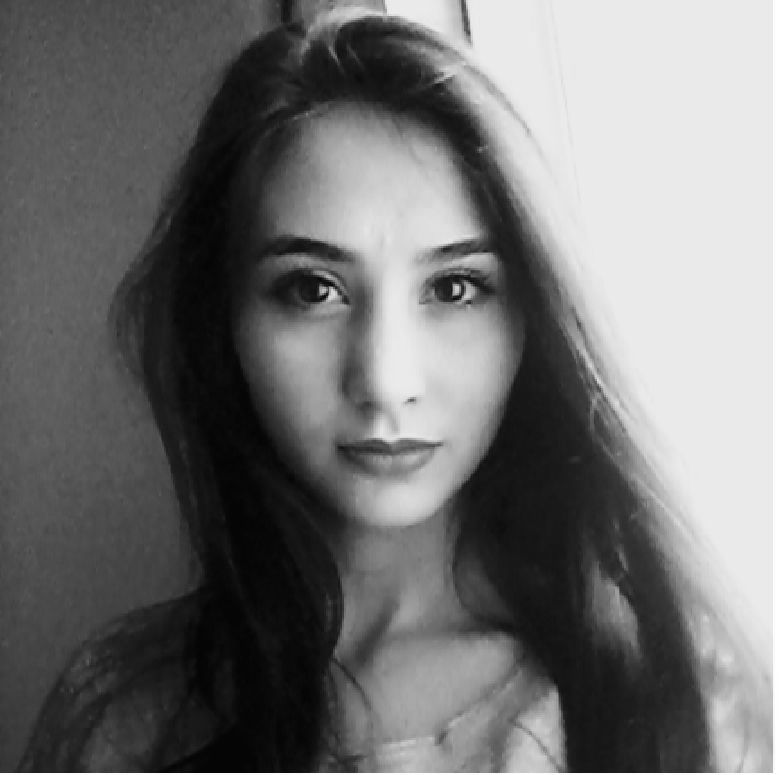
“All you can do after seeing this, is sit and think”
Carole Sarraf

“I've watched this video so many times, and I discover something new each time.”
ail ail
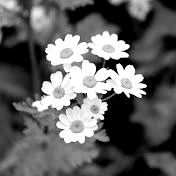
“De wereld is een betere plek met jouw content erin. Blijf maar komen.”

